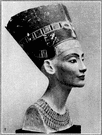The Unparalleled Power of Akhenaten
Part 4: Power and Beauty As the citadel of El-Amarna (for it was a citadel, surrounded by cliffs, since Akhenaten expected to have to fight against an army loyal to the Amen priests) became a reality, the pharaoh had one more surprise in store for the Egyptian faithful: Nefertiti, his queen, was to become co-regent. This was unheard of and certainly angered the Amen priests, devout patriarchs, even further. Egypt had had female pharaohs before, the most noticeable and famous being Hatshepsut, but the people had become accustomed to having a king on the throne and that king An innovation can also be seen in the art of the period. Beginning in the last few years of the reign of Amenhotep III, the statues and inscriptions on temple walls began to appear more real, more life-like (another indication that father and son were co-rulers). This movement continued and burst into full flower with the reign of Akhenaten. Rather than abstract images, the art produced when Akhenaten was on the Egyptian throne was dominated by realism, the idea that you could look from a sculpture or a wall carving into the eyes of the subject and see a striking resemblance. It was almost as if the spirit of the person or scene being described had been captured physically, rather than abstractly. In a society that believed that the spirit of a person did indeed live in such things as carved hieroglyphs on walls, this was an innovation indeed, one that was encouraged and likely even directed by the young king who had energy to burn and a legacy to create. Much of the art created in this period remains, and art historians can judge for themselves the effect that Akhenaten's direction had on the course of art history. Egypt at this time had been hit by a succession of shock waves, all of which changed the upper level of society in a very large way but affected the common people not so much, as they were too busy working and trying to survive. They certainly noticed that temples and statues were gone, replaced by new ones, many of them featuring the queen, something that wasn't generally done at that time. They certainly heard the grumbles about the king's new-claimed power and the queen's sudden new responsibilities. And the common people, when they were approaching death, would have to kneel before their king and ask for guidance, not only into how they had lived their life but also into how they would be received in the next life. It could also be argued that many common people were shipped off to El-Amarna to build the king's new citadel. But Egypt at this time, although the population was a majority of commoners, was all about the king and the priests and the landowners and slaveowners and business owners and other members of the upper class. It was to these people that Akhenaten was making his bid for power, and it was these people who were flabbergasted and most affected by his pronouncements and life-changing acts. They adjusted, in time, choosing to curry the favor of the vibrant new king and his beautiful king rather than start a revolution, which the Amen priests were clearly willing to do. Next page > A Bad End? > Page 1, 2, 3, 4, 5 |
|
Social Studies for Kids
copyright 2002–2025
David White



 having a queen who was subservient, just as the family structure of common people in Egypt at that time was. The priests especially but the rest of high society also had a difficult time accepting Nefertiti as their co-ruler, not the least because she was not of royal blood. She had also gained a new name with the change in religious emphasis: Nefer-Nefru-Aten, which means "Beautiful is the Beauty of Aten." It didn't take much imagination to conclude that Akhenaten was making a pronouncement that his wife was the most beautiful woman in all of Egypt (as most scholars agree that she was anyway) and perhaps worthy of the beauty of the gods.
having a queen who was subservient, just as the family structure of common people in Egypt at that time was. The priests especially but the rest of high society also had a difficult time accepting Nefertiti as their co-ruler, not the least because she was not of royal blood. She had also gained a new name with the change in religious emphasis: Nefer-Nefru-Aten, which means "Beautiful is the Beauty of Aten." It didn't take much imagination to conclude that Akhenaten was making a pronouncement that his wife was the most beautiful woman in all of Egypt (as most scholars agree that she was anyway) and perhaps worthy of the beauty of the gods.
